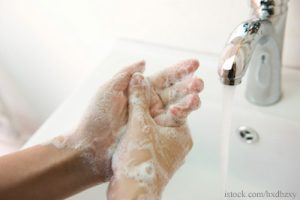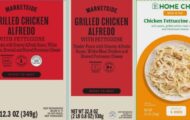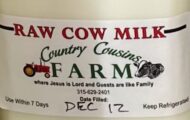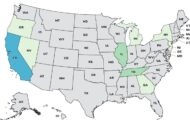The Partnership for Food Safety Education held a webinar last week all about fighting myths about food safety and kids. We’re running a series on those myths, since believing them can make you sick.
 The first myth is that just putting your hands under running water is enough to clean them before eating or preparing foods. Here’s the truth: rubbing hands with soap and water is the way to go. Make sure to scrub thoroughly for at least 20 seconds.. A recent study found that the most frequently missed areas are the fingernails, the backs of your hands, the thumbs, and the area between the fingers.
The first myth is that just putting your hands under running water is enough to clean them before eating or preparing foods. Here’s the truth: rubbing hands with soap and water is the way to go. Make sure to scrub thoroughly for at least 20 seconds.. A recent study found that the most frequently missed areas are the fingernails, the backs of your hands, the thumbs, and the area between the fingers.
Dirty hands spread infections. In fact, infections spread by unclean hands account for 50% of respiratory illnesses and 60% of gastrointestinal illnesses every school year. Other problems in schools include inappropriate placement of sinks, lack of access to hand hygiene products, and tsraffic flow problems.
To wash your hands effectively, wet hands with warm, clean running water and add soap. Rub hands together to make a lather. Continue rubbing for 20 seconds (sing “Happy Birthday to You” twice for an accurate count), then rinse under warm running water. It’s important to also dry your hands, using clean towels, disposable towels, or air dry. Multiple use towels are not safe.
Hand sanitizers aren’t the best option, because they don’t disinfect heavily soiled hands and aren’t effective at eliminating norovirus. But when running water and soap aren’t available, use a hand sanitizer with at least 60% alcohol. Towelettes with sanitizer are a good option, but still not as good as soap and water.
Remember to wash your hands before, during, and after preparing food; before eating; before and after caring for someone who is sick; before and after treating a cut or round; after using the bathroom, and after changing a diaper. And here’s something most people don’t think about: wash your hands after blowing your nose, coughing or sneezing, after contact with animals or pet food, and after handling garbage.





I thoroughly wash my hands with liquid soap (NOT antibacterial), then I rinse and repeat the hand washing/rinse. Then dry on a paper towel or hand towel. Two washings are better then one, when hands are likely to be contaminated after handling meat, pets, or using the bathroom, etc. Many people wash their hands without using soap, if they bother to wash at all. I won’t eat anything they may have touched.
Norovirus can be really tough to kill and it only takes about 20 viruses to make you sick (that’s not much considering there’s about 5 billion viruses in a gram of infected fecal matter). Washing with soap and water is so important.